Table Of Contents
Index
The first thing you will do as an electrician is WIRING. Running the cables for power and light - often called “roughing-in.”
This involves pulling cables through holes drilled in the studs and noggins of a partially completed house.
The brackets for the switches and power points are firstly nailed to the studs at 500mm for power points and 1,000mm for wall and architrave switches
It’s easy to tell the 6-amp lighting cable from the 10-amp power cable.
These cables are commonly called lighting cable and power cable.
Lighting cable is 1.5mm and power cable is 2.5mm This is actually circular mills but we will not be involved with the complexity of actually measuring the cable.
Australian cables will handle much more current than the ratings above, but the regulations specify almost no temperature-rise when maximum current is flowing and this means the cables will never get stressed, even when positioned in the roof-space on a very hot day.
You can also purchase 15-amp power points that take plugs (plug-tops) with a large earth pin. These need to be wired with 4mm cable.
The lighting cable has conductors (active and neutral) with a cross-sectional area of 1sq mm (for each conductor) and the power cable has a cross-sectional area of 2.5mm (for each conductor).
These cables will handle much more than 6-amps and 15 amps as the upgrading was done about 20 year ago when a limit of 12 to 15 power points per run was increased to an open quantity.
However no run will deliver more than about 16 to 20 amps as each is now terminated by a 16 amp circuit breaker for power and 10 amps for lighting.
Houses need a separate run to the oven (if electric), the kitchen and the laundry. These can all be 2.5mm cable. The oven needs to be 2400 watts maximum for a “10-amp” cable.
The remainder of the house can have one run to the rest of the rooms downstairs and one run the the all rooms upstairs.
Air-conditioners need a separate run to each unit.
Make sure every “power” device is less than 2,400 watts. This allows the standard “10-amp” cable to be used (2.5mm). (Ovens, heaters, tumble-dryers, air-conditioner, welders, etc)
Both the lighting and power cables are “flat cables” and are commonly called twin and earth.
They are also called TPS cables, referring to Thermoplastic Sheathed Cable or PVC plastic sheathing. This is also referred to “Tough Plastic Sheathed.”
The Active is always red, the Neutral is black and the Earth is green or yellow/green striped. Earth is always in the centre.
Active is called LIVE in some countries or HOT.
Neutral is always called Neutral.
Earth is sometimes called GROUND.
Some oven cables use the new standard:
- Brown - Red = Live
- Blue - Black = Neutral
- Yellow/green = Earth
If you can’t remember the new colour-coding, try this: When you get cold you go BLUE WITH THE COLD. Cold = Neutral Neutral = black Blue = Black
Lighting cable is 1.5mm - twin and earth approx $65 per 100m
Power cable is 2.5mm - twin and earth approx $100 per 100m
4mm Power cable - twin and earth approx $230 to $260 per 100m
Appliances over 2,400 watts require 4mm cable. This cable can supply up to 32 amps.
(you have to spend $230 to make a single run - for 100m roll). Some wholesalers will sell 4mm cable by the metre.
WIRING A HOUSE - called “Roughing-in.”
- Two different-sized cables are used to wire a house.
- The smaller-size is commonly called 6-amp LIGHTING and
- the thicker cable is commonly called 10-amp POWER
- Each “circuit” is commonly called a RUN and is terminated at the FUSE BOX with a CIRCUIT BREAKER.
- A small dwelling will require 1 lighting circuit and 1 power circuit.
- A wall oven will require a separate circuit.
- It is advisable to provide a separate run to the KITCHEN and
- 1 run to the LAUNDRY.
- For larger dwellings add:
- 1 power-run to UPSTAIRS and
- 1 lighting-run to UPSTAIRS.
- Plus 1 run to each air conditioner
- If you know bedrooms will use fan-radiators, allow a separate run to each bedroom.
Fortunately, cable-colours are RED, BLACK and GREEN/YELLOW.
However cables from a wall oven are BROWN, BLUE and GREEN/YELLOW and must be connected inside a JUNCTION BOX using 3 x 30amp double-screw connectors.
Use the following diagram to match the colours:

IDENTIFYING THE CABLES
It is essential to produce a wiring diagram either before or during the time when running the cables.
On top of this you MUST identify each of the cables at EVERY switch-point.
Generally, you will have “Active-IN,” “Active-OUT” and “Switched.”
Mark “Active-IN” with a marker pen with “A” at a point about 150mm from the end.
Mark the switched wire by nipping a small portion of the sheath with the pliers at about 150mm.
The other cable is obviously “Active-OUT.”
“POWER” runs - to power points
Start each run at the fuse box and drill 20mm holes in the studs with a spade-bit or auger drill. An auger drill has a spiral to remove the shavings from the hole.
It is best to run the cable along the top-plate of a a stud wall and drop it down at the location above the power-point, as this makes it easy to trace and replace the cable if a fault occurs as you are not trying to pull it through holes in the studs.
Terminate the wires though the bracket, leaving at least 300mm for easy connection.
Continue the run by pulling the cable through a new set of holes to the next location.
Terminate the cable with a 300mm “tail” and wrap the two ends together with tape.
Do this with each “loop” and make a plan of what you have done in case one or more of the wires cannot be found after the plastering.
To save cable, drill though the studs at 600mm from one outlet to the next and run the cable inside the stud wall at 600mm.
Before each sheet of plaster is fitted, the position of the wiring should be noted and a hole cut in the sheet and the wires pulled through by the plasterer.
If this is not done, you will have to refer to your wiring diagram and/or use one of our cable detectors. See Frontice Page for details of these projects.
FITTING OFF - connecting the switches, power points etc to the cables
Fitting-off involves connecting the switch mechanisms, power points, fluorescent light fittings, smoke alarms and bayonet (ceiling) fittings after the plaster has been completed.
Another section covers locating the wires and now you need to learn the art of preparing the wires for insertion into the various terminals.
All the wires are stranded and this makes it easy to twist two or more together and put them into a screw-terminal.
STRIPPING - the art of removing the insulation
There are various methods of removing the PVC sheath.
It is very soft and easy to “tear up the middle” as the grooves in the side of the cable allow this to be done.
Don’t remove any more sheath than you have to, as the max allowable exposure of the coloured wires is 35mm for light fittings and 75mm for power points.
You can bite the end of the cable with pliers and remove a small piece. This will allow you to tear open the sheath (along one of the side-grooves) to about 100mm.
Or you can use a “Stanley knife” (box cutter) to cut lightly along the groove on the side of the cable and this will allow you to open up the cable to 100mm. Remove the sheath completely by folding-over and cutting with a box cutter or the side-cutter section of your pliers.
The insulation on each conductor can be removed by putting the wire in the SIDE CUTTER section of the pliers and biting down until the pliers just hold the wire. By pulling the wire, the end will be removed. This is called STRIPPING. If you bite-down too hard, you will cut the wires. If you don’t bite down hard-enough the wire will simply “pull-through” the cutters and not get stripped.
If you find this difficult to do, you can get another pair of pointed nose pliers and hold the cable with them and lever your side-cutting pliers against the long nose pliers to remove the end of the wire.
Make sure you do not cut any of the strands.
You can also use WIRE STRIPPERS. Make sure they are set correctly for the size of wire you are stripping, so the strands of wire are not cut.
The actual length of the bare copper wires will depend on the terminal you are connecting to.
Some terminals will only allow direct insertion and you have to work out the length of the copper to expose by looking at how much wire is in the jaws of the pliers and how much protrudes from the side of the pliers. This is your gauge for direct insertion.
If two or more wires are to be twisted together, add a small extra length, because the length of the copper wire will be reduced due to twisting two wires together..
If a single wire is to be inserted into a light fitting or power point, the strands are to be twisted together by holding the pliers on the end of the strands and rotating the pliers. You will need to do this 4 to 6 times.
Then grip the pliers at about half-way up the copper and bend to 90 degrees. Then get the side of the pliers and bend the end over another 90 degrees.
Squash the wires together so that no strands are protruding.
It is VERY IMPORTANT that no strands are left “floating” outside the connection.
After finishing the connection, you should not be able to see ANY of the copper wires.
This is what makes you a perfectionist.
The connection must be TIGHT, NEAT, CLEAN and TIDY.
You cannot allow and of the copper wires to be seen where they enter the terminal. You MUST NOT cut the insulation and expose the wire at any point along the cable.
When wiring a switch mechanism, you will be able to connect the “Neutral-IN” and “Neutral-OUT” to the LOOP terminal on the switch.
You can solder and tape the earth wires but it is quicker to fit them into a 30-amp connector.
The connector must then be taped to the cables, before screwing the switch-plate to the wall bracket.
SCREW CONNECTORS
Any wires that are not screwed into a switch mechanism are joined (connected) via the “loop” terminal on a switch mechanism.
When more than two wires need to be connected, you MUST use a screw connector.
The most suitable connector is called a DOUBLE-SCREW 30 AMP OR 40 AMP CONNECTOR. See image:
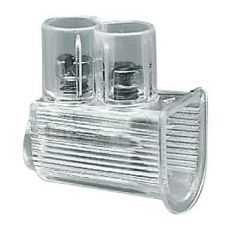
In most cases, the wiring at a SWITCH POINT will consist of: will consist of:
- 6-AMP cable entering the SWITCH POINT containing ACTIVE-IN, NEUTRAL and EARTH.
- 6-AMP cable exiting the SWITCH POINT - called ACTIVE OUT or LOOP to next switch point.
- 6-AMP cable exiting the SWITCH POINT to the light fitting - containing “Switched Active”, NEUTRAL and EARTH.
This will require 2 x 30amp screw connectors for the “loop wiring” (looped Neutral and looped earth).
LIGHTING - Method 1: loop at light
There are two ways to run the lighting wiring.
The first method uses the loop terminal at the light.
This method uses less wire, plus the cheaper red/white “Intermediate” cable.

The lighting cable runs through the ceiling
(called loops through the ceiling)
with twin red/white cable to each switch
LIGHTING - Method 2: loop at switch:

The lighting cable loops from one switch to the next
with lighting cable to each light
MORE LIGHTING information:
Each light is controlled by a switch, commonly known as a SWITCH MECHANISM. These click into a SWITCH PLATE so the “10A” cannot be seen.
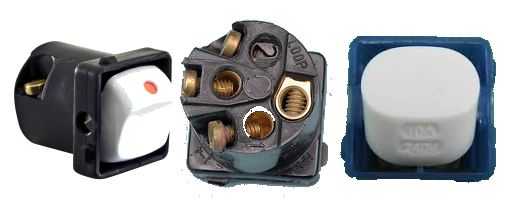
The switch mechanism sometimes has a red dot on top of the rocker.
All mechanisms have 10Amp printed on the bottom.
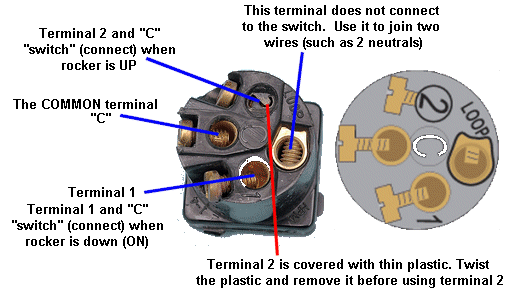
The SWITCH MECHANISM is actually a SINGLE POLE CHANGE-OVER SWITCH, shown in the diagram below:
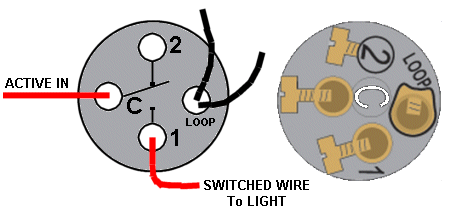
The SWITCH IS A SINGLE-POLE CHANGE-OVER SWITCH.
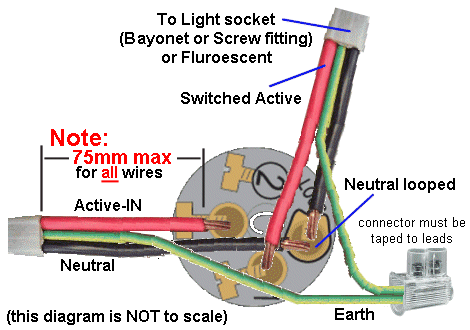
Wiring a switch mechanism (end of run)
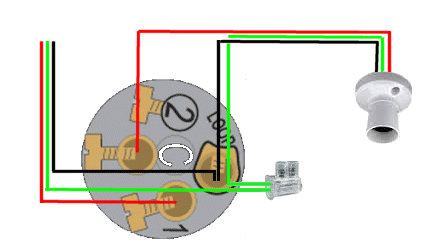
Wiring diagram for switch and batten holder
Normally, a switch will be wired in a LOOP SITUATION where the lighting cable will enter the SWITCH-POINT as ACTIVE-IN and will exit as ACTIVE-OUT. Another lighting cable will exit as SWITCHED-ACTIVE to the light fitting. Here is the wiring for LOOP SITUATION:

Wiring a switch mechanism (LOOP SITUATION)
Note the comments in the diagram above - 75mm leads MAX and
connectors must be taped to wiring before placing in wall cavity.
Wiring a BATTEN HOLDER (globe holder)
A Batten Holder fits to a ceiling to hold a globe. The globe can screw-in (called ES - Edison Screw) or “Click-In - called BC - Bayonet Connection or Bayonet Cap.
The earth wire must go into the terminal marked “E”, even though it does not connect to any part of the globe.
The TPS sheathing (the white PVC outer sheathing) must be removed to allow a maximum of 35mm for the red, black and earth wires.
Unscrew the 4 screws and you will see through 2 of holes while the other terminals align with the pins connecting to the globe. The pins to the globe can be wired as Active or Neutral, depending on the way the cable is fitted. ;
Here is the Batten Holder wiring:
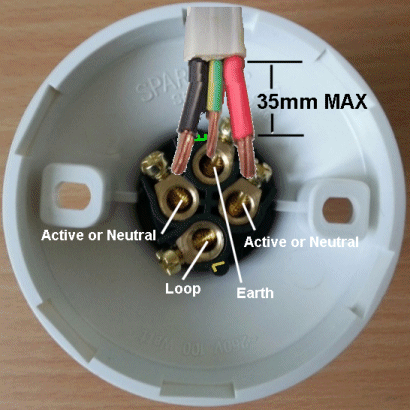
WIRING A BATTEN HOLDER
LIGHTING - two-way switching
The first thing you have to remember is the circuit for two-way switching.
Two-way switching allows a light to be turned ON via two different switches. The position of the rocker on the switch does not represent ON of OFF as the other switch may have turned the light ON. turned the light ON.
Here is the circuit:
Remember this:
- The power (the active) comes from the first switch.
- Connect the first switch to the second via red/white cable.
- The Common terminal of the second switch goes to the light and the Neutral goes to the light.
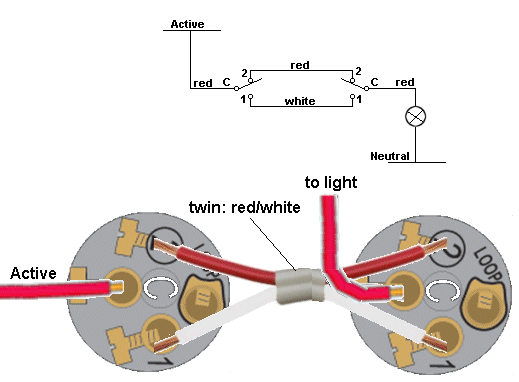
TWO-WAY SWITCHING CIRCUIT CONNECTING TO THE SWITCH MECHANISMS
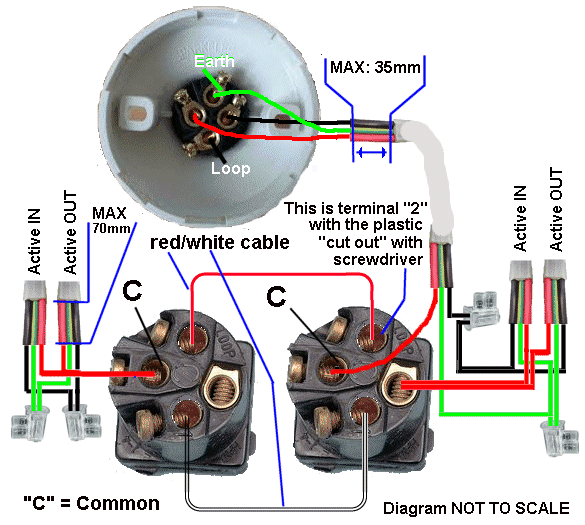
TWO-WAY WIRING
At the first switch, active-IN and Active-OUT are joined and only the active wire is needed.
Red/white cable is taken to the second switch.
At the second switch, the switch-wire is picked-up from “C” and the Neutral, plus earth is taken to the batten holder.
SPECIAL NOTE:
When wiring a TWO-WAY on stairs, one of the switches will be downstairs and one switch will be upstairs.
A double-storey house will have two lighting circuits, one for DOWNSTAIRS and one for UPSTAIRS.
These will be on two separate RCD’s (Residual Current Detectors) and the stair-light MUST be connected to either the upstairs lighting circuit or downstairs lighting circuit.
As you can see in the diagram above, it looks like you can take the active from up-stairs and the neutral from downstairs.
But this will cause both the upstairs RCD to trip and the downstairs RCD to trip as the upstairs RCD will see current in the active line and NO CURRENT in the neutral. The downstairs RCD will see current in the neutral and NO CURRENT in the active.
You must take the NEUTRAL from upstairs to downstairs as shown in the following diagram:

note: All the circuit (the power) for the STAIR LIGHT is taken from the upstairs WIRING.
The downstairs wiring is NOT touched.
The STAIR LIGHT can be controlled from the downstairs circuit:

All the circuit (the power) for the STAIR LIGHT is taken from the downstairs WIRING.
The upstairs wiring is NOT touched.
THREE-WAY SWITCHING
Three-way switching is just an extension of two-way switching with an INTERMEDIATE SWITCH in the middle.
The intermediate switch is an expensive item ($25.00 each at local electrical wholesalers) or $8.00 on eBay (plus postage).
The Intermediate switch is placed in the middle of a TWO-WAY CIRCUIT:

The INTERMEDIATE SWITCH has 4 terminals
The intermediate switch action:

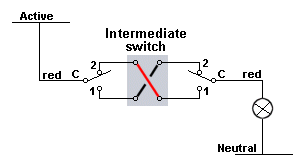
The Intermediate switch has numbers: 1,1,2,2 or letters:L1, L1, L2, L2.
All the numbering and lettering can be confusing.
Get out your multimeter set to low ohms and hold the switch so the action of the switch is EXACTLY as shown in the diagrams above.
The switch will have to be turned 90 degrees when fitting into the switch plate so the rocker action is correct.
Nothing will be damaged if you make a mistake as only the active line is used for ALL the connections.
Here are the diagrams for intermediate switches marked with L1, L1, L2, L2 and 1, 2, 3, 4:
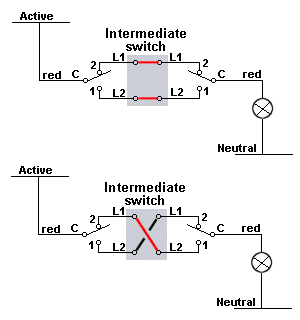

Quick Links
Legal Stuff
Social Media


